Invertebrates are fascinating creatures that make up more than 95% of all animal species on Earth. These organisms do not have a backbone however, this does not hinder their ability to adapt and thrive in nearly every environment. From the depths of the ocean to the highest trees, invertebrates play crucial roles in ecosystems. This article explores the various types of invertebrates and their unique characteristics.
What Are Invertebrates?
Invertebrates are incredibly diverse creatures, ranging from microscopic organisms to large species like giant squids. They can be found in almost every habitat on Earth, including oceans, forests, and deserts. Their lack of a backbone is compensated by other structural features like exoskeletons, which provide support and protection.
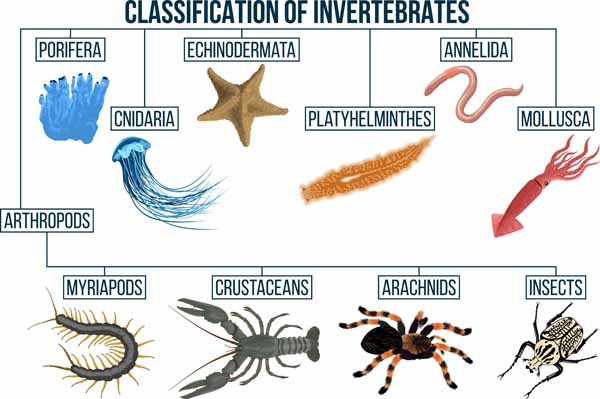
Fun Facts
- Sea Star Regeneration: Sea stars, also known as starfish, can regenerate lost arms. In some cases, a single arm can grow into a whole new sea star!
- Snail Slime: Snails produce a special mucus that allows them to slide smoothly over surfaces, even sharp ones, without getting hurt. It’s like their very own slimy skateboard.
Major Types of Invertebrates
Arthropods
Arthropods are the largest and most diverse group of invertebrates. They include insects, arachnids (spiders and scorpions), myriapods (centipedes and millipedes), and crustaceans (crabs, lobsters, and shrimp). Arthropods have segmented bodies, exoskeletons made of chitin, and jointed appendages.
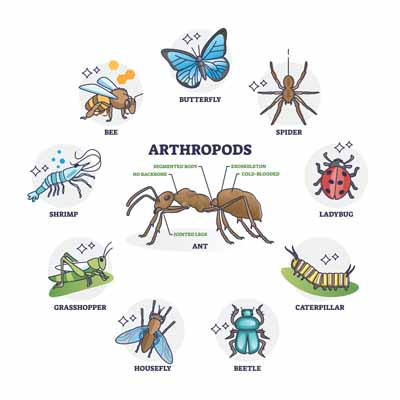
- Insects: Insects have three main body parts: head, thorax, and abdomen. They usually have six legs, antennae, and often wings. Examples include butterflies, ants, and beetles.
- Arachnids: These creatures have two main body segments and eight legs. Common examples are spiders, scorpions, and ticks.
- Crustaceans: Typically found in aquatic environments, crustaceans have two pairs of antennae and limbs adapted for swimming. Examples include crabs, lobsters, and barnacles.
- Myriapods: Characterised by their many legs, myriapods include centipedes, which have one pair of legs per body segment, and millipedes, which have two pairs per segment.
Molluscs
Molluscs are a diverse group of invertebrates that include snails, slugs, clams, and octopuses. They are known for their soft bodies, which are often protected by a hard shell. Molluscs can be found in marine, freshwater, and terrestrial environments.
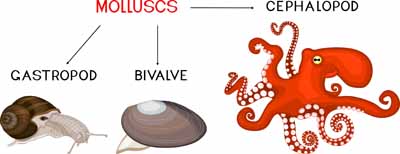
- Gastropods: This group includes snails and slugs. They have a single, usually spiralled shell and a muscular foot for movement.
- Bivalves: Bivalves, like clams, oysters, and mussels, have two-hinged shells and are mostly aquatic. They filter feed by siphoning water over their gills.
- Cephalopods: Cephalopods include octopuses, squids, and cuttlefish. They are known for their intelligence, ability to squirt ink, and tentacles.
Annelids
Annelids, or segmented worms, include earthworms, leeches, and polychaetes. They are characterised by their segmented bodies and bristles called Setae. Annelids play vital roles in soil aeration and nutrient cycling.
- Earthworms: Earthworms are terrestrial annelids that burrow through soil, enriching it by decomposing organic matter.
- Leeches: Leeches are often parasitic, feeding on the blood of other animals. They are found in freshwater environments.
- Polychaetes: Mostly marine, polychaetes have parapodia (appendages) that aid in locomotion and respiration.
Cnidarians
Cnidarians are aquatic invertebrates that include jellyfish, corals, and sea anemones. They have a simple body structure with a single opening that serves as both mouth and anus, surrounded by tentacles armed with stinging cells called cnidocytes.
- Jellyfish: Jellyfish are free-swimming cnidarians with a gelatinous, umbrella-shaped body and long tentacles.
- Corals: These colonial cnidarians build calcium carbonate skeletons, forming coral reefs.
- Sea Anemones: These sessile (non-moving) cnidarians attach to surfaces and use their tentacles to capture prey.
Echinoderms
Echinoderms are exclusively marine invertebrates that include starfish, sea urchins and sea cucumbers. They have a unique water vascular system and a body plan based on five-part radial symmetry.
- Starfish: Starfish, also known as sea stars, have five or more arms radiating from a central disc. They can regenerate lost arms.
- Sea Urchins: Sea urchins have a round, spiny shell and feed on algae.
- Sea Cucumbers: Sea cucumbers have elongated bodies and leathery skin. They partake in breaking down organic matter on the ocean floor.
Fun Facts
- Jellyfish: Jellyfish have been around for over 500 million years, making them older than dinosaurs!
- Glowing Critters: Many invertebrates, like certain types of jellyfish and fireflies, can produce their light through a process called bioluminescence. It’s nature’s built-in flashlight!
- Octopus Intelligence: Octopuses are super smart! They can solve puzzles, use tools, and even escape from enclosures. Each of their eight arms has a “mini-brain” that helps with movement.
Characteristics of Invertebrates
- Lack of Backbone: The primary characteristic of invertebrates is the absence of a vertebral column. Instead, many have exoskeletons or hydrostatic skeletons for support.
- Diverse Body Plans: Invertebrates exhibit a wide range of body structures, from the simple shapes of cnidarians to the complex segmented bodies of arthropods.
- Reproductive Strategies: Invertebrates have varied reproductive methods, including sexual and asexual reproduction. Many produce large numbers of offspring to ensure survival.
- Sensory Adaptations: Invertebrates have developed sophisticated sensory organs despite lacking a backbone. For example, insects have compound eyes and antennae, while cephalopods have advanced vision.
- Ecological Roles: Invertebrates play essential roles in ecosystems, such as pollination by insects, soil aeration by earthworms, and reef-building by corals. They are also crucial in food webs as both predators and prey.
Conclusion
Invertebrates are incredibly diverse and vital to the health of ecosystems worldwide. Understanding the types of invertebrates and their characteristics is essential to appreciate their importance and roles in maintaining ecological balance. From the smallest insects to the largest cephalopods, invertebrates continue to fascinate and inspire many nature enthusiasts including scientists. As we learn more about these creatures, it becomes clear that their preservation is crucial for the sustainability of our planet.
For more such informative/interesting blogs, visit Mother’s Pet Kindergarten.

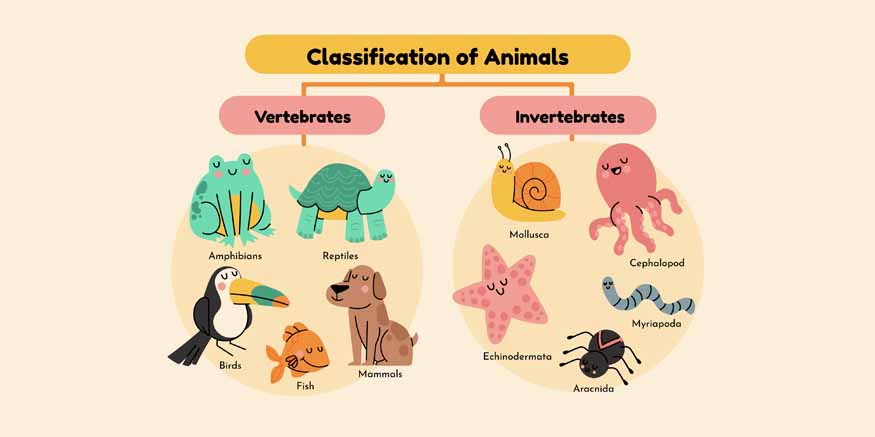
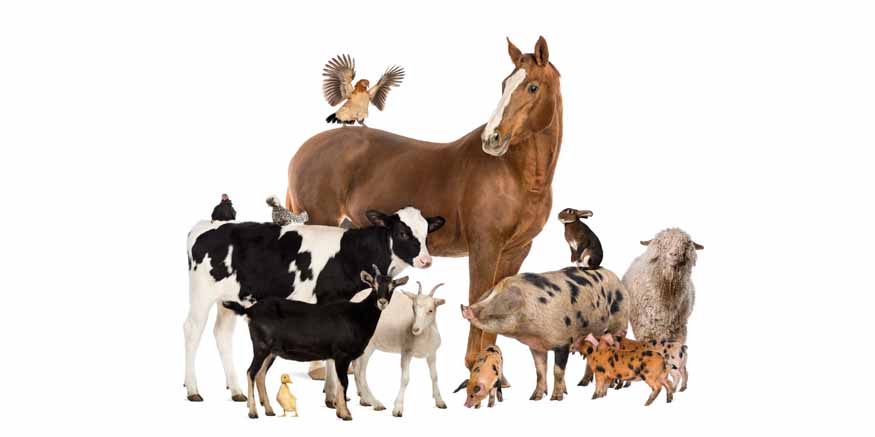
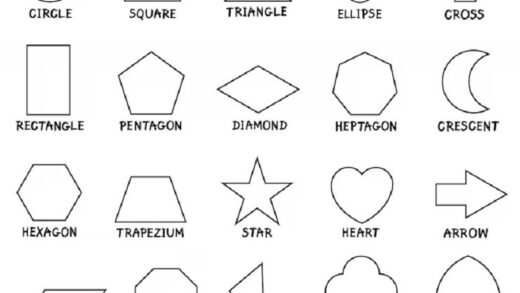
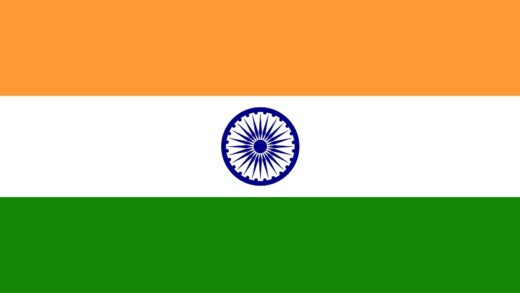








Recent Comments